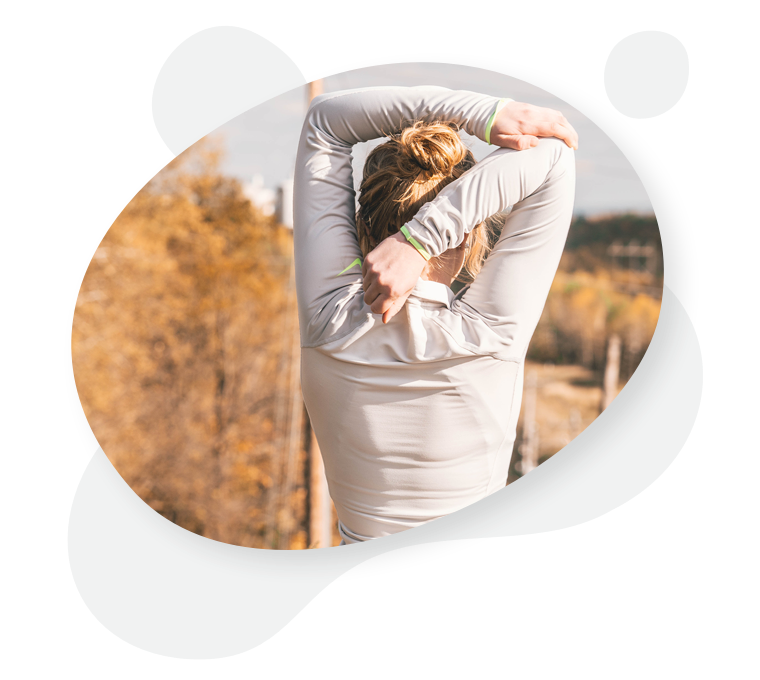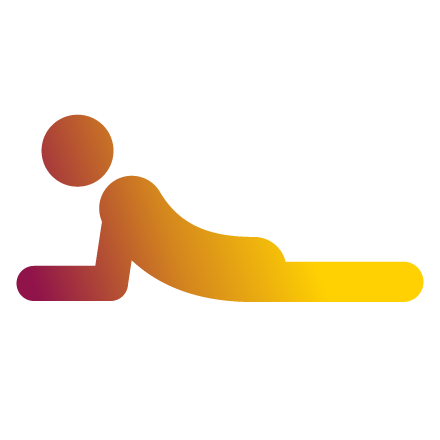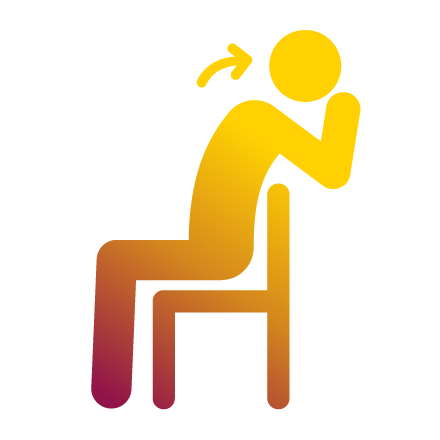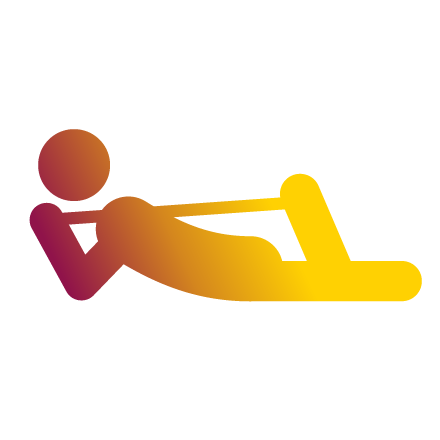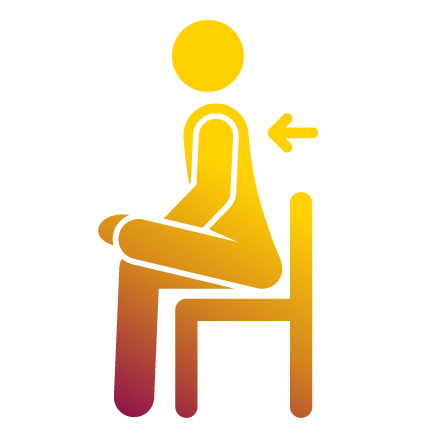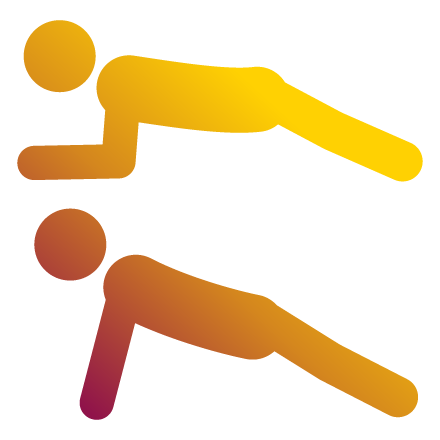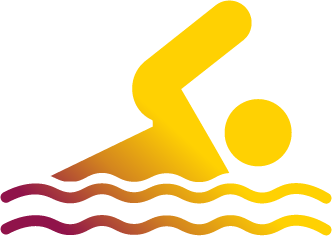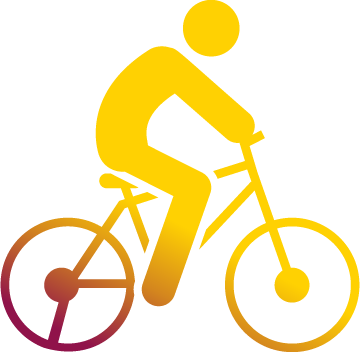This information is general exercise information for people with axial spondyloarthritis (ax-SpA) and may not suit all individuals. Your healthcare professional is the best person to advise you on what activities are suitable for you depending on the severity of your condition and your treatment plan.
What benefits does exercise bring?
Staying active with regular exercise can help improve your symptoms.1,2
Regular physical activity can help you: 1-3
- Reduce pain and stiffness
- Strengthen your muscles
- Maintain good posture
- Maintain mobility in your spine
- Combat fatigue
- Alleviate low mood
- Lose weight
- Keep your heart in good shape
- Improve your sleep and your overall health
What exercises should I be doing?
Finding an exercise that you enjoy doing might help you keep it up regularly and build it into your everyday routine. Stretching, low-intensity aerobics, breathing exercises and strengthening exercises are recommended for people with ax-SpA.2,4 Before you start any type of exercise, talk to your doctor. Alternatively, you could speak to an exercise physiologist for exercise recommendations or to put together an exercise plan.1
Stretching exercises
Stretching exercises may improve your posture and may help to maintain mobility in the spine and improve flexibility.1,2 A stretching program should be done consistently, targeting different parts of the body and different movements so that the whole body is stretched and moved daily. Below are a few stretching examples:5
To print off a copy of the stretching exercises or
to save a copy to your computer or phone, click here.
Disclaimer: Before starting a new exercise regime, speak with your doctor.
Aerobic exercises
Aerobic exercises are activities that increase blood flow through the heart. They may help to improve breathing function, endurance and mood, and lower disease activity, pain and fatigue in people with ax-SpA.2
Warming up is important to improve circulation and increase body temperature so the joints and muscles are less stiff, making exercise easier and reducing risk of injury. Examples of warm–up activities include walking at half speed or performing flexibility exercises for 10–15 minutes.4
Examples of aerobic exercises are:1,6
It is also important to cool down after exercising. You can do this by gradually slowing down with gentle, sustained movements before coming to a complete stop after your exercise.7
Breathing exercises
Breathing exercises may help to improve mobility and chest expansion. It is important to include these exercises in your exercise regimen or routine. Simply follow and repeat these quick steps:4
Strengthening Exercises
Strengthening exercises may help to improve the performance of muscles, which in turn will help you to move efficiently and safely and support good posture. For people with ax-SpA, some of the most important muscles to strengthen are the abdominal and core muscles, which support the spine. Strengthening these muscles may help to reduce stress on the spine and therefore minimise back pain.2
Examples of strengthening exercises are:8
What if it hurts when I exercise?
The level and type of exercise that can be done varies from person to person. Some people may be able to do a variety of exercises, whereas others may only be able to do very low-intensity exercises or some basic stretches.1
You may experience pain in your joints and muscles when first exercising. Exercise is an important part of managing your condition, and it can be useful to speak with an exercise physiologist to work out the type and amount of exercise that is right for you and your condition. If the pain feels unusual or severe or lasts for more than two hours after you have stopped an activity, you should speak to your doctor.1
Speak with your doctor about how heat and cold packs may help. They have been known to minimise swelling or pain after exercising.1 Cold packs can help numb the feelings of pain, and heat packs can help relax your muscles and joints.9 Try to plan your exercise for times when you are experiencing the least pain — generally when you are least tired and your treatment is having the maximum effect.1
Exercising when you have flares can be tough, and can make even the most gentle exercises seem difficult. If you are having issues with this, speak to your doctor. You can also seek the advice of an exercise physiologist to find out what they would recommend for when you experience a flare.
References: 1. Arthritis Australia. Taking control of your ankylosing spondylitis. Available from: arthritisaustralia.com.au/wordpress/wp-content/uploads/2020/09/Ankylosing-Spondylitis-WEB-2019.pdf Accessed: August 2025. 2. Spondylitis Association of America. Exercise. Available from: spondylitis.org/about-spondylitis/treatment-information/exercise/ Accessed: August 2025. 3. Arthritis Foundation. How to beat arthritis fatigue. Available from: arthritis.org/healthwellness/healthy-living/managing-pain/fatigue-sleep/how-to-beat-arthritis-fatigue Accessed: August 2025. 4. UpToDate. Patient education: Arthritis and exercise (Beyond the Basics). Available from: uptodate.com/contents/arthritis-and-exercise-beyond-the-basics Accessed: August 2023. 5. Creaky Joints. 6 daily stretches for ankylosing spondylitis that can help ease pain. Available from: creakyjoints.org/about-arthritis/axial-spondyloarthritis/axspa-healthy-living/ankylosing-spondylitis-stretchesexercises/ Accessed: August 2025. 6. Arthritis Foundation. Building a walking workout. Available from: arthritis.org/health-wellness/healthy-living/physical-activity/walking/building-a-walking-workout Accessed: August 2025. 7. Better Health Channel. Arthritis and exercise. Available from: betterhealth.vic.gov.au/health/conditionsandtreatments/arthritis-and-exercise Accessed: August 2025. 8. Spondylitis Association of America. Sample spondyloarthritis exercise program. Available from: spondylitis.org/wp-content/uploads/2020/12/SAA_Exercise_Flyer_8.5x11_Update_WEB.pdf Accessed: August 2025. 9. Arthritis Australia. Dealing with pain. Available from: arthritisaustralia.com.au/managing-arthritis/living-with-arthritis/dealing-with-pain/ Accessed: August 2025. AC-005092-00. AU-RNQ-250084. August 2025.

